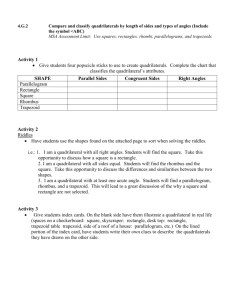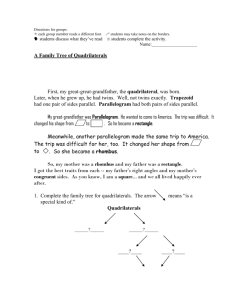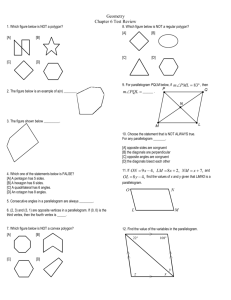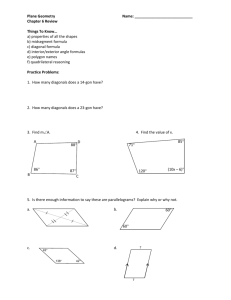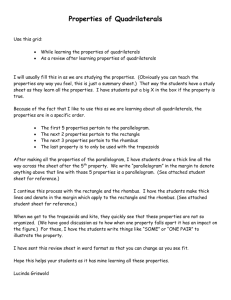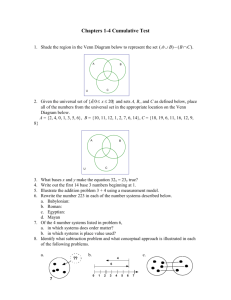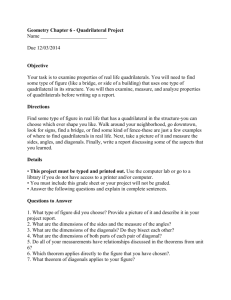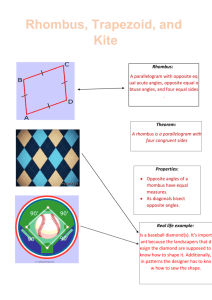5.5 Properties of Quadrilaterals
advertisement
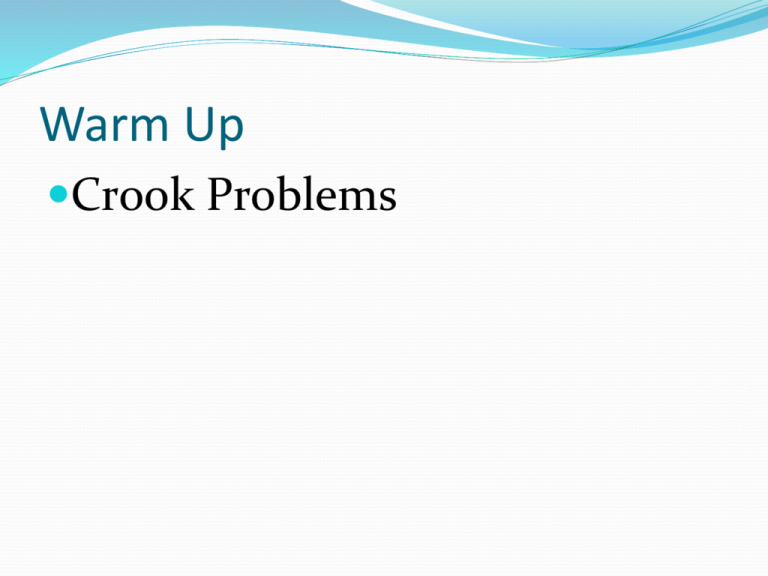
Warm Up Crook Problems Polygon: A many-sided plane figure, simple and closed. Consists entirely of segments. (no curves) Consecutive sides intersect only at endpoints. Each vertex must belong to exactly 2 sides. Names of Polygons 3 sided: 4 sided: 5 sided: 6 sided: 7 sided: 8 sided: 9 sided: 10 sided: 12 sided: 15 sided: triangle quadrilateral pentagon hexagon heptagon octagon nonagon decagon dodecagon pentadecagon Special Quadrilaterals: Parallelogram: a quadrilateral with both pairs of opposite sides parallel. Rectangle: a parallelogram with 1 right angle. Rhombus: a parallelogram with all sides congruent. Square: a rectangle and a rhombus. Quadrilaterals: A four sided polygon Special Quadrilaterals: Kite: a quadrilateral with 2 pairs of congruent adjacent sides. (2 disjoint pairs of consecutive sides) Trapezoid: a quadrilateral with 1 pair of parallel sides. (called the bases, non-|| sides are the legs, upper base angles and lower base angles) Isosceles Trapezoid: a trapezoid with congruent legs. Section 5.5 Objective: Students will be able to identify properties of special quadrilaterals. Parallelograms 1. 2. 3. 4. Opposite sides are ∥ and ≅. Opposite angles are ≅. Consecutive angles are supplementary Diagonals bisect each other. Rectangles 1. 2. 3. It’s a parallelogram. It has 4 right angles. The diagonals are ≅. Kites 1. Two pairs of ≅ adjacent sides. 2. The diagonals are ⊥. 3. One diagonal is the ⊥ bisector of the other. 4. One of the diagonals bisects a pair of opposite angles. 5. One pair of opposite angles are ≅. Rhombuses 1. It’s a parallelogram and a kite. 2. All sides are congruent. 3. The diagonals are the perpendicular bisectors of each other. 4. The diagonals bisect the angles. 5. The diagonals divide the rhombus into four congruent right triangles. Squares 1. 2. It’s a rectangle and a rhombus. The diagonals form four isosceles right ∆s. (45°– 45°–90° right ∆s) Isosceles Trapezoids 1. 2. 3. 4. The legs and base angles are ≅. The bases are parallel. The diagonals are ≅. Consecutive base ∠s are supplementary. Venn Diagram Using your quadrilateral properties, place the names of the quadrilaterals below in the Venn diagram. Isosceles trapezoid Rhombus Rectangle Trapezoid Square Parallelogram Quadrilateral Venn Diagram Quadrilateral Trapezoid Isos. Trap. Parallelogram Rect. Sq. Rhom. Venn Diagram Using the completed Venn diagram, decide if each of the statements 1–10 is true or false. 1. 2. 3. 4. 5. False False True True False 6. 7. 8. 9. 10. False True True False (all are par.) True Show your work! Homework p.245 #5–7, 11-13, 19, 23 Exit Card Find the values of w, x, and y in the parallelograms below. 36 ° (12w) ° 90 144 ° 2y 5x 80 50 Exit Slip B Given: BCDF is a kite. BC = 3x + 4y CD = 20 BF = 12 FD = x + 2y C F D Find: The perimeter of BCDF.
